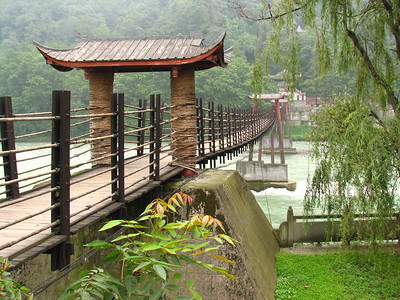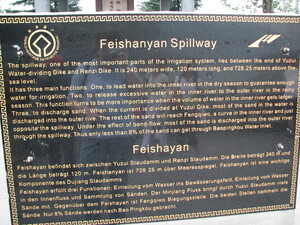Mount Qingcheng and Dujiangyan

Mount Qingcheng and the Dujiang Irrigation System comprise the intellectual and spiritual centre of Taoism and an ancient water management system that has survived up to the present day.
In 142 CE, the philosopher Zhang Ling founded the doctrine of Chinese Taoism at Mount Qingcheng. It now holds eleven Taoist temples, constructed in the traditional architecture of western Sichuan. The origins of the Dujiangyan Irrigation System date back to 256 BCE, when a scheme making subtle use of the local topography was set up to counter the devastating flooding caused by the Min River. The original system has been preserved, but modern materials and technology have been utilized to enable it to perform until today.
Community Perspective: Dujiangyan Irrigation System nowadays is set up like a theme park, “a nice place to walk around; [but] the genius design of the irrigation system was hard to appreciate”. Mount Qingcheng is another cable car experience.


Map of Mount Qingcheng and Dujiangyan
Community Reviews
Frederik Dawson

My first impression while I stepped out from my bus to the gate of Dujiangyan was irritating, it was a very fast 60 kilometers high speed train ride from Chengdu North Station to Dujiangyan city within 35 minutes, but the bus from the station to the site was maybe one of the slowest buses that took exactly 35 minutes for just less than 6 Kilometers without bad traffic! However, when I started to look around, I was starting to impress the area.
I did not enter Dujiangyan Scenic Area immediately but decide to see the old town area which has been rebuilt after the earthquake. The old town was very nice, the most impressive structure was the big, covered bridge built in Sichuan architectural style with extravagant details. Then I entered into the scenic park, the park was beautiful with small fountains, Chinese gardens and shrines. I walked along the river and had a good time by looking forts and pagodas on the cliff top on the opposite side of the river. I walked until I reached the suspension bridges and found that there was a dike restoration with many dozers tried to strengthen the ancient dikes. Since there was nothing much to see, I crossed the suspension bridge to another side of the park. This area called Yulei Scenic Park. I saw the famous Erwang Shrine, which was maybe the biggest shrine in the scenic area.
After shrine I walked along the river until I reached a pathway to Yuleishan Peak. It was a nice easy walk; along the hiking route I saw two gate forts, viewing pavilions and many shrines with lovely view of Dujiangyan scenic area, Mount Qingcheng and the whole city. At the end of hiking route was the beautiful Shidian Shrine or ten room shrines, this shrine was very unique with its design as two galleries act as a gate to the main city shrine on the hill with amazing roof decoration making this place to be my favorite spot in Dujiangyan. The way finally leaded me back to the old town and the big bridge. Dujiangyan was a nice place to walk around; the genius design of irrigation system was hard to appreciate, but I could not deny it uniqueness among the list of World Heritage Site, also I started to like Sichuan vernacular architecture, so making Dujiangyan, a fine site to spend half a day.
wilson ang
the trip was for Mount Qincheng for my second day in Chengdu , i rented a mini van to head there .
Going there ,We were diverted to the rear of the mount , since the road heading to the front of MT Qincheng was close, i talked with the lady in the ticket counter in the Rare entrance and she told me that the view in the front was totally different on the scenery at the back, anyway , she said the entrance ticket was cheaper at the back at 20 yuan compare to the front entrance ticket which is 90 yuan , i guess WHS should divide this in to three site, 2 for mount Qincheng ( front and back ) and 1 for Dujianyan , and i should be back again next time, since the front entrance was not open.
The mount was a nice climb , there is two cable cars heading to the top ( the peak is white cloud temple) , Try to buy the ticket of the cable car going up and down , since u will not have enough time coming down if you are NOT staying over night in Mt Qincheng ,(If you decided to buy the ticket going up only and suddenly wanted to buy the cable car ticket coming down, u will be charge double coming down ,on the counter there on top. so that means u will be paying three rides per sector, You have no option nor bargain with the people in the ticket counter , since there are guards who are maintaining the site are soldiers , Chinese army soldier) the last cable car closes at 6 pm , first cable cars ride is about 20 minutes while the second is about 45 minutes , their is two mountain ridges to over come on the second cable car, as u head up the air will be going to be thin, so try to stay fit before the trip,From the first cable car to the second cable car there is a climb of 45 minutes , and the climb is quite steep,After the second cable , there will be another 1 hour to climb up. Another set of trail and stairs, there are small buddha statues that are etch on the wall, there is a small wind vent ( 3 meter by 2 meter in dimension ) in the center of the mountain , the stairs is usaully wet, the stairs heading up is quite slippery , but is a nice climb up, since u will see the small buddha on the wall of the small vent going up.After an hour u will reach the top which is the WHITE CLOUD TEMPLE , not much up there, only a 7 foot Multiple arms Buddha . the climb is exception nice, will let u realize how fit u are . The only thing nice heading to the top are the buddhas on the mountain wall, up all at a size of 1 feet high , attach to the walls going to the temple.And of course the mountain nice scenery ,
ahh by the way , after the second cable car and your still heading up White cloud Temple, there will be a cross trail , there will be two confusing direction going up, This is after the destroyed hostel, there will be two sets stair on the cross trail, one with arrow going up to the white cloud temple, while the other is heading down also going to the white cloud temple, go to the route down , since the stairs going up, you will discovers its not an easy trail going up, is NOT Climbable, they must have been destroyed by the Earthquake on 2008. there is actually no visible trails.
this is the third day in Chengdu and i was a little apprehensive , if my stay in Chengdu will give me enough time to visit the Dujianyan Irrigation system , since my main purpose to Chengdu is the Leshan DAFU , the Dujiangyan was full when i was there, but most of the people who went there that day were locals, the place was more of a garden park rather than a site , it is well maintain, with fancy shops located along the way inside the park, there is a corner stall that sell statues, that also have several TV explaining how the irrigation system works,in several language subtitle .
I was amaze on the structure how they stop water in the old days, a used of multiple 30 cm round stone that is place in a bamboo wooden circular roll as u can seen on the picture ,with a triangular wooden peg to hold the water , try to visit this site and u will know with out this irrigation, Chengdu will be a big lake,
Els Slots

The night before I visited Dujiangyan, I had dinner with an Australian girl that I met earlier that day. She planned to go horseback riding in Songpan, a four-day trek. “I’m going to visit an irrigation system tomorrow” is what I told her. “It’s an ancient one”, I added. But I already lost her interest. Sometimes it’s hard to explain being a WHS traveller. I really did look forward to visiting this site though, wondering what would be there to see. And I don’t like horses anyway.
The next day I took a public bus to Dujiangyan, a city about 60 km northwest of Chengdu. At the city entrance, there’s a most amazing sight: a huge rock (measuring at least 150 x 30 meters) with a golden horse statue on top, and a sign “Top Tourist City of China”. Well, for sure I wouldn’t be the odd visitor here. Direct tourist buses to Mount Qincheng are available from the city's modern main bus station, but I opted for city bus #4 to the irrigation system.
Anticipating this visit I had had visions of muddy fields, me being the only visitor trying to find my way and pick up at least some of the story. The entrance to the Dujiangyan Irrigation System however looked like one for a theme park. A well-signposted hiking route leads you through the park and its main sights. It’s quite a walk, but you can also hop on one of the golf carts that shuttle passengers. The site even has signs in German! Although I must say that the explanations lost a lot of depth in the multiple translations, 10 sentences in English usually resulted in 3 German sentences.
It’s rather difficult to make a water management site attractive to a non-specialist visitor. The Chinese have made the most of it by including a park with a water theme, large explanation signs at the points of interest and maintaining some shrines dedicated to the victims of the floodings and to Erlang Shen, a Chinese god with a third true-seeing eye in the middle of his forehead who helped Li Bing with his work. Highlights for me were the Erwang temple and the Anlan Suspension Bridge.
P.S. November 2007: I did visit the other half of this WHS (Mount Qingcheng) at the end of my trip around China. I focussed more on its natural features than on the Taoist heritage. See my review of the Sichuan Giant Panda Sanctuaries for that.
Zack Culvert
While visiting Jiuzhaigou (see review)in China, you want to score a few WHS, take a half day to visit this site of the oldest continuously used waterworks in the world. (2300 years)
I hired a car (busese are also available, but it's local Chinese)from Chengdu, the jumping-off point for Jiuzhaigou and Tibet. While there, also cover the museum at Sanxingdui, which features larger-than-life bronze statues and figurines from the lost civilization (3-4,000 years old)discovered accidentally. We are talking about 1.5 meter bronze masks with eye-stalks a la Star Wars.
Also within a day's drive is Dazu and Emei Shan. So by staying in Chengdu, I was able to cover 5 WHS (add Jiuzhaigou and Huanglong) in one week. I will fill in the photos later from my Apple.
Community Rating
- : David Gang XU Tourb Kbtwhs Ssong.x Elisabeth Fransisca Situmorang Alejandro Lau
- : Khuft Oscar Wu Szucs Tamas
- : Yinming Zhang Bin YAO WEI Ludvan Jeffrey Chai Ran Jon Eshuijs Chenboada Dwight Zehuan Xiao Pchxiao
- : Jan Zimmermann Peter Alleblas Hanming Luke LOU Xiquinho Silva
- : Eric PK Thibault Magnien Alex Marcean Everett Kevin McFarland
- : Zoë Sheng Els Slots Shandos Cleaver Joyce van Soest Christravelblog Frederik Dawson
Site Info
- Full Name
- Mount Qingcheng and the Dujiangyan Irrigation System
- Unesco ID
- 1001
- Country
- China
- Inscribed
- 2000
- Type
- Cultural
- Criteria
-
2 4 6
- Categories
- Religious structure - Indigenous Structure - Civic and Public Works
- Link
- By ID
Site History
2000 Inscribed
Site Links
Unesco Website
Official Website
Related
In the News
Connections
The site has 19 connections
Art and Architecture
Constructions
Damaged
Geography
History
Human Activity
Religion and Belief
Timeline
Trivia
WHS Hotspots
WHS Names
World Heritage Process
Visitors
117 Community Members have visited.
